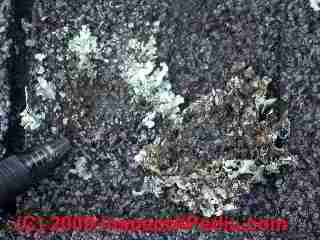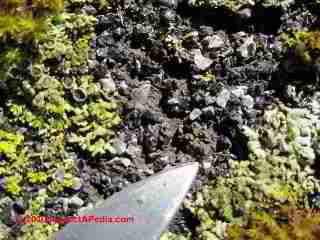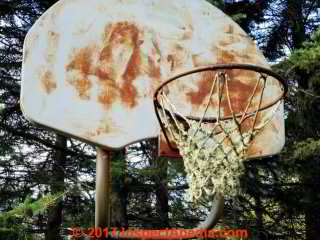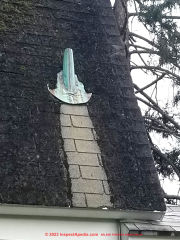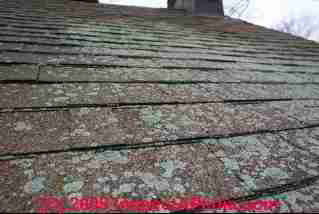 Photo-guide to Lichens Damage on Roofing Surfaces
Photo-guide to Lichens Damage on Roofing Surfaces
- POST a QUESTION or COMMENT about how to identify, cure, or prevent lichens damage to roof surfaces
Lichens formation on building roofs: why do lichens grow on roof surfaces? Do lichens harm the roof surface? How should we remove or prevent lichens growth on building surfaces?
This article describes and provide photographs of lichens growth that occurs on buildings and in nature and we provide advice about handling lichens growth on roofing surfaces.
We provide photographs of lichens growth on roofs help identify these substances in nature and on buildings. Microphotographs of algae, lichens, moss, mold: high magnification views of algae, lichens, moss, mold to 1200x detail characteristics of these organisms.
What is the difference between moss and algae or moss and lichens? Do they affect buildings differently? Comparing asphalt shingle damage from lichens with asphalt shingle damage from moss growth. We provide photos and text to help distinguish among algae, lichens, moss and mold growths on any surface.
We include links to references useful in the identification of algae, moss, lichens, and mold. Our photo at page top shows moss on an asphalt shingle roof.
InspectAPedia tolerates no conflicts of interest. We have no relationship with advertisers, products, or services discussed at this website.
- Daniel Friedman, Publisher/Editor/Author - See WHO ARE WE?
What does Lichens look like on buildings, in nature, and in the microscope?
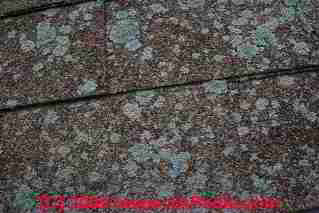 How do I Recognize Lichens on a Building?
How do I Recognize Lichens on a Building?
What does lichens growth look like on an asphalt shingle roof and how do we distinguish this material and its effects from algae, moss, or other roof problems?
Lichens on an asphalt shingle roof in New York (left).
Our photo (left) shows blue-green lichens covering a significant portion of the roof surface, and below we provide closeup photographs showing just what lichens does to the roof surface if you try to remove it
Lichens, one of the most hardy growth organisms found in nature, can grow in harsh conditions. Lichens is often found growing on roof shingles, especially asphalt and wood shingles as we show here. Lichens may even grow on some window glass.[1]
What is Lichens?
 Lichens is an admirably tough symbiotic organism made up of two partners, typically an algae (usually a green algae or Chlorophyta, less often a cyanobacteria)
Lichens is an admirably tough symbiotic organism made up of two partners, typically an algae (usually a green algae or Chlorophyta, less often a cyanobacteria)
and a fungus (usually an Ascomycete, occasionally a Basidiomycete). [2]
The fungus (the microbiont half of the lichens duet) obtains nutrients out of the surface on which the lichens is growing (quite often stone) as well as primarily out of the organism's contact with air.
The algae (the phycobiont) provides photosynthesis to the duet.
Lichens on hot dry rock in Mexico (left)
Our photo (left) shows lichens growing on sun-baked rock in Boca de la Canada in Guanajuato - central Mexico.
Lichens not only grow in almost every environment on earth, they have some useful functions as a source of perfume, dye, or medical compounds.
Nevertheless, most people don't enjoy seeing lichens on their building, and as we describe here, lichens may shorten the life of some roofing materials.
 at left we illustrate lichens growing in a very different climate - in Iceland. Photo courtesy of J. Church.
at left we illustrate lichens growing in a very different climate - in Iceland. Photo courtesy of J. Church.
Don't be mistaken by our beautiful lichens photos of this symbiant growing on rocks and roofs.
Lichens on cold damp rock in Iceland (left).
Lichens also is widely found growing on organic surfaces such as trees, leaves, and on occasion wood trim on buildings, and perhaps surprising to some, even on plastic or PVC building siding and trim as well as on aluminum siding and windows.
Unlike a pure fungus or mold, however, lichens does require sunlight in addition to nutrients. LIchens needs small amounts of moisture but can tolerate extended periods of extreme dryness or "dehydration".
That may help explain why unlike moss, sun exposure and dry conditions won't stop or prevent its growth on a building roof or wall while moss would be less successful in such locations.
Is lichens on a roof as much of a problem as moss?
Yes and no, as we discuss below.
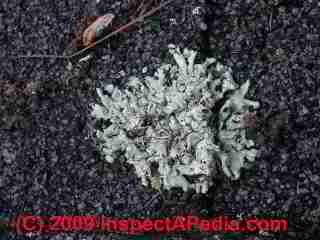
Because lichens growing on a roof surface does not have as much thickness of body as moss, it will hold less water on the roof surface and is less of a wear factor than moss.
Our photographs (above and below) show lichens growing on an asphalt roof shingle in situ (above left). In the photo where our pen is inserted for scale (above right) we had "picked" the spot of lichens gently and flipped it over.
Our pen points to the hole left in the asphalt shingle as the lichens had such a good grip on the mineral granules that when removing the lichens it brought some of the roof protective coating along with itself.
If you click to enlarge the photo at above right you'll see the actual mineral granules from the shingle adhered in the "roots" of the lichens.
Moss Damage Compared with Lichens Damage to Roofs
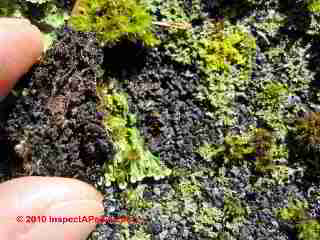 Our photographs below show a Two Harbors Minnesota asphalt shingle roof with heavy moss and lichens growing on the same surface.
Our photographs below show a Two Harbors Minnesota asphalt shingle roof with heavy moss and lichens growing on the same surface.
You can see that comparing the loss of mineral granules where we have gently lifted off moss (below left) and where we used a knife blade to gently lift off lichens from the shingle surface (below right), both growths have loosened the mineral granule coating and exposed the organic shingle substrate in a similar fashion.
Notice that both roof photos show that both moss and lichens are happy to co-exist on the same shingle surface.
Our photo shows testing where moss was lifted off of the shingle, and at right, cup lichens was pried off of the roof using the tip of a knife blade.
Because moss is a thicker growth on roof surfaces, we suspect that its ability to hold water and moisture on the roof surface is greater than that of lichens.
So in some circumstances and climates, moss damage may be as severe or even more severe than lichens damage to a building roof, and we suspect that the degree of moss or lichens damage also varies by roofing material, with still more severe moss and water damage on wood shingle roofing.
If we have only lichens growing on a roof surface we would be less quick to try to clean it off since lichens not only has a tighter "grip" on the roof surface but the cleaning process for lichens risks doing more harm than good to the roof surface.
Removing the protective granules from an asphalt shingle or mineral-granule coated roll roofing surface is going to reduce the future life of that roof covering.
Moss and lichens are more than a cosmetic issue on many kinds of roofing materials - asphalt shingles, roll roofing, wood shingle roofs, wood shake roofs.
By holding moisture against the roof surface lichens but more so moss speed the wear of the asphalt shingle surface in freezing climates by increasing frost damage to the mineral granule coating on the shingles.
How to Remove & Prevent Lichens Growth on Building Roofs, Siding, & Trim
Reader Question
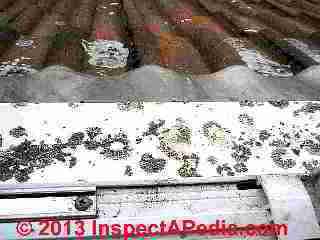 We have these deposits on the roofing tiles that seem to have spread onto the outside loft dormer window sills and sashes which are PVC.
We have these deposits on the roofing tiles that seem to have spread onto the outside loft dormer window sills and sashes which are PVC.
This looks very unsightly as its dark grey against white PVC.
I was trying to identify what it is from your site info., but I’m not sure. It adheres quite firmly to the PVC in places, but can be scraped away.
I’ve included a picture for you, taken through the (opened) window.
What do you think it is and how do I get rid of it (from the windows)? I would be grateful for any help/advice. - P.W. 8/17/2013
Reply:
The roof tile and PVC trim deposits about which you inquire and show in your photo are undoubtedly lichens.
Although personally I'm enchanted by the toughness and beauty of lichens, I have to agree that agree lichens growing on your home's roof fascia and trim is unsightly.
I don't usually see it on PVC - but lichens is the most hardy stuff imaginable - it's found worldwide, very often on stone as well as on many asphalt shingle roos, worldwide on stone, and sometimes on plastic, PVC, and aluminum siding, wood, and trim.
Unlike its presence on asphalt roofing, lichens on clay or plastic roof tiles, even on slate, is not likely to cause rapid damage nor have a large effect on roof life. But as your photo illustrates, it can be unsightly.
Our photo above, showing thick lichens growth on a basketball net in Two Harbors, Minnesota illustrates that lichens can grow on a variety of materials besides rocks, roofs, and tree trunks.
Options for Removing Lichens from Building Surfaces
You could physically remove or clean the lichens-infected building surfaces using scrubbing and a TSP substitute outdoor cleaner such as deck cleaner, taking care not to let runoff drain down and stain building siding. But the lichens will probably return as apparently it likes the chemistry of your PVC trim.
In some circumstances a power washer is used to remove lichens, but I'd be careful of that approach too as blowing high pressure water into building materials or openings can create costly, hidden damage, even mold contamination.
I am reluctant to advise painting the trim with a fungicidal-treated paint as you'd convert a no-maintenance surface to a recurrent need for repainting.
- Watch out: do not use bleach or swimming pool algecides
on surfaces that may be damaged by those chemicals. Bleach can cause a stone surface to turn yellow or may even cause further erosion; swimming pool algecides may be very corrosive and may also be environmental contaminants. [7] - Watch out: do not use acid cleaning on surfaces that may be damaged
nor where acid will be applied in quantity or concentrations as to contaminate the soils, kill plants, contaminate the environment; and of course do not use any cleaner without consulting the appropriate MSDS for that product. - Watch out: we do not recommend using power washers
nor sand-blasters to clean buildings of algae or moss because of the damage caused to roof and wall surfaces.
How to Clean Off & Prevent Future Lichens Re-growth on Building Surfaces
Lichens Removal/Prevention on Stone, Slate, Similar Surfaces: Cleaning & Using Biocides
Richardson and also Young et als. have written about the control of lichens growth on stone (presumably for the benefit of art, artifacts, and grave sites) and performed tests using Quaternary ammonium formulations and Tri-n-butyltinoxyde. [3][4][5]
Richardson points out that keeping the surface dry can reduce or prevent growth through use of an "external water repellant treatment" such as silicone resin water repellant coatings. He warns however that a toxic biocidal treatment is needed to eradicate existing lichens growth. The biocide chosen should not be one that itself harms the surface or material to which it is applied.
Examples of other problems (besides those listed above) that may arise using a biocide include
- increased water retention of the treated surface
- chemical reactions with the treated surface
- toxic effects on other wildlife that should not be harmed
For practical help in lichens prevention on buildings we looked to experts in cemetery cleaning & maintenance. Cemetery experts recognize that the water-trapping effects of lichens on stone surfaces can lead to frost and other deterioration of gravestones and monuments. [7][9]
- Clean the surface
by gently physically removing the lichens (or other growths).
Watch out: as our own article points out above, trying to mechanically scrub or power-wash to remove lichens from asphalt shingle roofs is going to damage the shingles and shorten roof life still further; but on stone, PVC, vinyl, aluminum or other building surfaces the physical removal of lichens is often feasible. - Rinse with clean water and brush gently
but frequently during cleaning - Wet the surface and treat with D/2
- a proprietary architectural antimicrobial that is described by Chicora as follows
D/2 Architectural Antimicrobial is a proprietary combination of octyl dimethyl ammonium chloride, oioctyl dimethyl ammonium chloride, oidecyl dimethyl ammonium chloride, and alkyl dimethyl benzyl ammonium chloride with surfactants, wetting agents, and buffers. It has a pH of 9.5. It is noncombustible.
There are no specific hazards in handling either the concentrate or diluted solutions. You should avoid splashing the liquid in your eyes. Ask the supplier for a Material Safety Data Sheet (MSDS) for additional safety information.[7]
Watch out: do not continue with this process of cleaning and treating if the material or surface being treated is unstable or appears to be becoming unstable. See our warnings above about roof shingles. - Biocides
applied to treat lichens (or moss or fungal) growth on building surfaces may be more successful if applied during dry weather so that the treatment does not get rain-washed away before it has sufficient time to act. [9] - Re-application of silicone treatments:
if you find success using a silicone treatment or biocide followed by silicone water repellant treatment you may nevertheless still have to re-apply the treatment frequently, possibly every 1-3 years. Our own field experience with silicone water-resistant treatments is that outdoors they weathered off of treated surfaces in 1-2 years. [DF]
Copper or Zinc Strips or Flashing can Prevent Lichens and Moss growth on Roofs
Some other measures that resist or retard moss growth also work for lichens - changing the chemistry of the host surface so as to create an imbalance between the algae and the fungus.
For example you'll notice in some of our roof lichens photos that no lichens grown on the roof slope below areas where there is copper flashing; it appears that the copper oxides washing down over surfaces below retard both moss and lichens growth. So cleaning followed by some strategic placement of copper strips might work for you.
Above, this photo by Arlene Puentes illustrates how the copper salts washing down from this copper plumbing vent boot flashing prevented moss and growth on the roof of an older New York home.
Lichens Removal/Prevention on Plaster, Wood, & Similar Surfaces
- Rhom/Haas Biocidal products include Rocima 382 Biocide, a dry film preservative intended for use against fungi, lichens, and algae. This is a water-based treatment that may also benefit from a subsequent sealant coating.[8]
- Be sure to select and apply this or any other biocide, paint, coating, or treatment in accordance with the manufacturer's instructions and the product's MSDFS.
Lichens growth diagnostic questions
Is there a correlation between the lichens growth and sun or shade or moisture levels? Often I see more lichens growth on roof surface areas that are moist and shaded, though indeed lichens is tough stuff - and is found all over the world even under very hostile conditions like rock surfaces in northern Norway or sun-baked rock surfaces in central Mexico. Certainly lichens tolerates sunlight and hot dry conditions where moss will not grow.
Is there a correlation between this growth and different plastic products on the building exterior. I suspect that your PVC components are of a particular chemistry that's part of the problem. For that reason, a call to the manufacturer, getting a technical person who's interested rather than a stonewalling "customer service person" might be instructive.
Reader follow-up:
Thanks for your response. I managed to remove the deposits using soap and water and a piece of scouring pad (that you use to clean pans etc). It was a bit difficult reaching the outside window frame, but I managed it in the end.
I’ve attached a photo taken through the open window. There’s a section of flashing (probably lead) just below the sill, and you can see more deposits on the tiles below it. The rest of the roof (away from the dormer) is not affected.
Hope that helps - P.
Research: Lichens on Buildigns
- Algae, Lichen and Mould Growths [PDF] Technical Information Sheet, Ibstock Brick Limited, U.K., (2004) 0870 903 4017
- Lichens of North America, Irwin M. Brodo, Yale University Press, 2001, ISBN-10: 0300082495, # ISBN-13: 978-0300082494
Quoting from Library Journal:
Lichens are a combination of a fungus and an alga but have a unique structure and appearance quite different from either. Existing worldwide and growing on a variety of surfaces, including rocks, soil, and trees, they may appear leafy, shrubby, mossy, crusty, or jellylike and are seen in a wide range of colors, from brilliant oranges, yellows, and reds to dull grays and browns.
This huge new book, written by a world authority on lichens and emeritus research scientist at the Canadian Museum of Nature, Ottawa, provides information on about 1500 of the roughly 3600 recognized North American lichens.
Part 1 introduces lichens in 14 clearly written chapters that discuss their biology, ecology, geography, environmental roles, and collection.
Part 2, the heart of the book, is a guide that offers identification keys to groups, genera, and species and their descriptions, with accompanying photographs and North American distribution maps. The more than 900 truly beautiful, full-color photos were taken by the Sharnoffs, nature photographers whose work has been widely published in National Geographic, Smithsonian, and elsewhere.
Of value to professionals and amateurs alike, this book is certain to be a classic reference for decades to come. Highly recommended for academic and research libraries and for public libraries where interest warrants; libraries needing only a brief yet informative introduction to lichens should consider William Purvis's inexpensive Lichens (Smithsonian Institution, 2000). William H. Wiese, Iowa State Univ. Lib., Ames - [7] Chicora Foundation, "Cleaning", Chicora Foundation, PO Box 8664, Columbia SC 29202, Website: http://www.chicora.org/cleaning.html, Tel: 803-787-6910
- Harris, SY, Building Pathology, Deterioration, Diagnostics, and Intervention, Samuel Y. Harris, P.E., AIA, Esq., ISBN 0-471-33172-4, John Wiley & Sons, 2001 [General building science-DF] ISBN-10: 0471331724 ISBN-13: 978-0471331728
- Journal Folia Geobotanica, Springer, Netherlands ISSN1211-9520 (Print) 1874-9348 (Online) IssueVolume 11, Number 2 / June, 1976 DOI10.1007/BF02854759 Pages217-22
- [1] Mellor, Ethel. "The decay of window glass from the point of view of lichenous growths." Journal od the society of glass technology 8 (1924): 182-186.
- [2] Oksanen, Ilona. "Ecological and biotechnological aspects of lichens." Applied microbiology and biotechnology 73, no. 4 (2006): 723-734.
- [8] Rociima (TM) 382 Biocide [PDF] Dry Film Preservative Against Fungi and Algae [and Lichens], Rhohm/Haas Biocides,
- [6] Young, M. E., H-L. Alakomi, I. Fortune, A. A. Gorbushina, W. E. Krumbein, I. Maxwell, C. McCullagh et al. "Development of a biocidal treatment regime to inhibit biological growths on cultural heritage: BIODAM." Environmental Geology 56, no. 3-4 (2008): 631-641.
Contributor Thanks
Thanks to Arlene Puentes for photo contributions above on this page
- Arlene Puentes [Website: www.octoberhome.com ] , an ASHI member and a licensed home inspector in Kingston, NY, holds five International Code Council Certifications, New York State DOS Certified Code Enforcement Official, ASHI Member 210232, NYS Home Inspector License No. 16000095212and has served on ASHI national committees (Bylaws, Standards), as well as HVASHI Chapter President. Ms. Puentes can be contacted at ap@octoberhome.com She is a frequent technical contributor to InspectApedia.com.
...
Reader Comments, Questions & Answers About The Article Above
Below you will find questions and answers previously posted on this page at its page bottom reader comment box.
Reader Q&A - also see RECOMMENDED ARTICLES & FAQs
On 2018-08-21 by (mod) - spray-on roof cleaner
A spray cleaner that contains an algecide or fungicide may kill off lichens and some of that dead lichens may wash off of the roof.
Take care not to spray bleach that then runs down and stains lower roof areas or the building siding below.
On 2018-08-21 by Terry
Will Spray and Forget Roof Cleaner or Wet and Forget kill lichens and are they safe for roofs?
On 2018-04-04 by (mod) -
Mitzi
It's not likely that lichens would be found growing on an indoor surface; more likely it's a fungus, ie. mold. I can 't assess the damage from a brief e text; you want to find and fix the leak source; large areas of contiguous mold (> 30sqft) merit professional remediation .
On 2018-04-04 by Mitzi
Jelly lichen is growing in a corner inside my house. How bad is this ? What shld i do? Any advice ?
On 2017-12-30 by (mod) -
John, can you show us some sharp photos? Use the ADD IMAGE icon next to the Comment button.
On 2017-12-30 by John Farman
I have just notices, on the concrete tiles of my lower roof, hundreds of small white circular growths about 2 inches in diameter. I ve never noticed them before and they look really unsightly. Can you tell me what they are and whether they can be removed.
On 2017-05-05 by Rusty - Webspinner insect problems in Perth
Hi from Perth Western Australia,
One problem that i am going through at the moment is an infestation of insects called Webspinners. My glazed clay tiled roof has a good amount of lichen on it and also a population of these insects that spin a web tube on the battens and beams under the tiles and come up to feed on the lichen.
They sort of look like an earwig and are an insect called Embioptera. Another side effect of lichen, is if you have a low pitch roof with tiles on, the rain water can be slowed down by the lichen and build up to cause leaks, this is a problem i am going through as well in the back area of my home.
It was built around WW2 when there was building supply shortages and is a little dodgy in some areas.
On 2017-02-01 by (mod) - insurance coverage dropped due to lichens
Martin,
Forgive me but this sounds absolutely absurd.
First there is no evidence that six shingles with lichens growth correlate with a measurable change in roof life, leak risk, storm protection - at least not until some dope aggressively scrubs the shingles to try to remove the lichens, thus damaging the roof.
Rather than waste hours arguing and documenting with people who have perhaps zero interest in client service, reasonability, and roof data on lichens, I would replace the six shingles, take a photo of the repair, and send it to your insurer with an appropriate salutation.
On 2017-02-01 by Martin
My insurance company is threatening to drop my coverage because I have less then six shingles with lichen located 2-4 inches wide. How can I remove the existing situation? I'm confident on preventive measures for the future. Thanks
On 2017-01-19 by (mod) -
Bill:
I would stay away from any aggressive physical cleaning: lichens clings very strongly to the roof surface - assuming you're talking about asphalt shingles or asphalt-roll roofing. Pulling it off pulls off granules and destroys the roof.
Products like Moss-Be-Ware discussed at https://inspectapedia.com/roof/Roof_Moss_Removal.php are also successful with lichens.
Lichens can be successfully prevented or at least minimized (depneding on climate) by choosing an algae/lichens-resistant asphalt shingle product when re-roofing. I also have had good success by installing metal strips high on the roof: metal salts washing down the roof also are toxic to both algae and lichens that like to grow on roof surfaces. You can see this effect for yourself, unequivocally. Just notice those areas on a lichens-covered roof where lichens is NOT growing. Typically you'll see its below metal flashings.
See this photo of a wood roof: https://inspectapedia.com/roof/Mossy_Wood_Shingles637-DFs.jpg
found in this article: MOSS on ROOFS - at https://inspectapedia.com/roof/Roof_Moss_Removal.php
I hope you'll read through the articles in this roof stain/algae/lichens/moss discussion that begins at STAINS on ROOFS https://inspectapedia.com/roof/Roof_Stain_Diagnose_Remove.php
On 2017-01-19 by Bill
I have a lichen problem on my roof that has motivated me into looking into the best way to get rid of the lichens and to prevent future development. I have yet been able to physically see or talk to anyone who has addressed a way to prevent future development of lichen.
I live in south eastern Massachusetts and I am seeking information to help with my problem. I will be installing a new roof soon and would like to get it right the first time. I have read about strips of zinc or copper. Does anyone have any experience with this method?
On 2016-05-23 by (mod) - removing lichens is difficult since it tends to bite onto its growth surface
Susanne,
I agree that removing lichens is difficult since it tends to bite onto its growth surface pretty hard; pulling it off by any means may damage the surface, even simple scrubbing with plain water and a stiff brush. But you can try that. Keep in mind that it will recur as the conditions that caused it to grow will remain;
Sure you could try coating the siding with a preservative stain but those too have chemicals that you may not want leaching off into the waterway;
Check with your local envrionmental protection agency (That's the Ministry of Environment in BC at http://www.env.gov.bc.ca/epd/ ) to see how they feel about installing copper flashing along roofs or walls; the copper salts running down a roof or siding are very effective at killing off and preventing lichens growth - if you're patient.
On 2016-05-23 by Susanne
I own a float home on the ocean in a protected bay off the coast of British Columbia. We had lichen growing on the wood siding. I want to remove it safely and then repaint/restain. As i am in an environmentally sensitive area, i don't want to use a product that can run off and hurt the waterway.
Is my only choice a stiff brush, phosphate free soap and water? Once i clean the surface, is there a paint or stain product you would recommend that will help repell the lichen?
Question: OK to roof over lichens?
(Apr 23, 2012) ken said:
All i like to know is if i can roof over a roof that has lichens.
Reply:
Yes as long as you are roofing over a dry surface and the roof surface is rather flat. If there are thick lichens (or moss) growths that make an uneven roof surface you may want to remove those.
...
Continue reading at MOSS on ROOFS or select a topic from the closely-related articles below, or see the complete ARTICLE INDEX.
Or see these
Roof Stain Diagnosis, Repair, Prevention Articles
- STAIN DIAGNOSIS on ROOFS - home
- ALGAE, FUNGUS, LICHENS, MOSS on ROOFS
- BLACK ROOF STAIN CAUSES
- BLACK or GREEN ALGAE STAINS on ROOFS
- BLACK or GREEN ALGAE STAIN REMOVE / PREVENT
- CHIMNEYS, STAINS on / near
- DEBRIS STAINS on ROOFS
- EXTRACTIVE BLEEDING on SHINGLES
- LICHENS on ROOFS
- MOSS on ROOFS
- POWER WASHING ROOFS
- RUST STAINS on ROOFS
- SOOT STAINS on ROOFS
- TARRY BLEED on ROOFS
- TOBACCO JUICING SHINGLE STAINS
- WHITE STAINS on ROOFS
- TEST LABS - ROOF SHINGLE
Suggested citation for this web page
LICHENS on ROOFS at InspectApedia.com - online encyclopedia of building & environmental inspection, testing, diagnosis, repair, & problem prevention advice.
Or see this
INDEX to RELATED ARTICLES: ARTICLE INDEX to BUILDING ROOFING
Or use the SEARCH BOX found below to Ask a Question or Search InspectApedia
Ask a Question or Search InspectApedia
Try the search box just below, or if you prefer, post a question or comment in the Comments box below and we will respond promptly.
Search the InspectApedia website
Note: appearance of your Comment below may be delayed: if your comment contains an image, photograph, web link, or text that looks to the software as if it might be a web link, your posting will appear after it has been approved by a moderator. Apologies for the delay.
Only one image can be added per comment but you can post as many comments, and therefore images, as you like.
You will not receive a notification when a response to your question has been posted.
Please bookmark this page to make it easy for you to check back for our response.
IF above you see "Comment Form is loading comments..." then COMMENT BOX - countable.ca / bawkbox.com IS NOT WORKING.
In any case you are welcome to send an email directly to us at InspectApedia.com at editor@inspectApedia.com
We'll reply to you directly. Please help us help you by noting, in your email, the URL of the InspectApedia page where you wanted to comment.
Citations & References
In addition to any citations in the article above, a full list is available on request.
- Asphalt Roofing Residential Manual from ARMA the Asphalt Roofing Manufacturers Association Website https://www.asphaltroofing.org/product/residential-asphalt-roofing-manual/ ,
- Building Pathology, Deterioration, Diagnostics, and Intervention, Samuel Y. Harris, P.E., AIA, Esq., ISBN 0-471-33172-4, John Wiley & Sons, 2001 [General building science-DF] ISBN-10: 0471331724ISBN-13: 978-0471331728
- Building Pathology: Principles and Practice, David Watt, Wiley-Blackwell; 2 edition (March 7, 2008)
- In addition to citations & references found in this article, see the research citations given at the end of the related articles found at our suggested
CONTINUE READING or RECOMMENDED ARTICLES.
- Carson, Dunlop & Associates Ltd., 120 Carlton Street Suite 407, Toronto ON M5A 4K2. Tel: (416) 964-9415 1-800-268-7070 Email: info@carsondunlop.com. Alan Carson is a past president of ASHI, the American Society of Home Inspectors.
Thanks to Alan Carson and Bob Dunlop, for permission for InspectAPedia to use text excerpts from The HOME REFERENCE BOOK - the Encyclopedia of Homes and to use illustrations from The ILLUSTRATED HOME .
Carson Dunlop Associates provides extensive home inspection education and report writing material. In gratitude we provide links to tsome Carson Dunlop Associates products and services.


